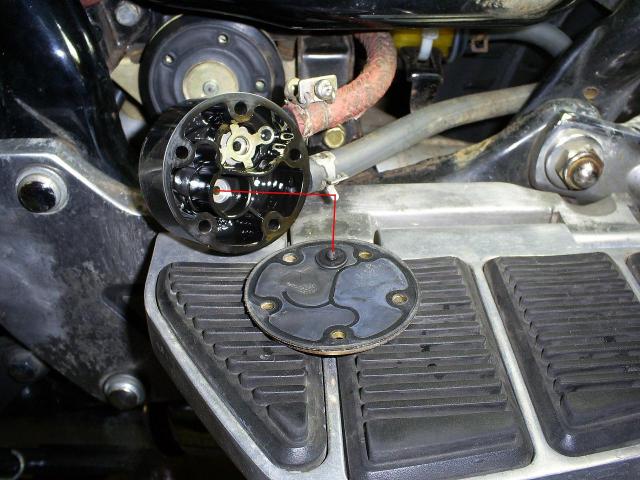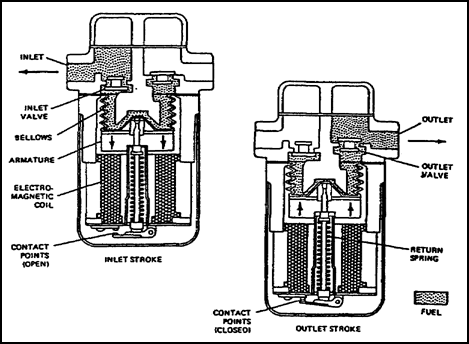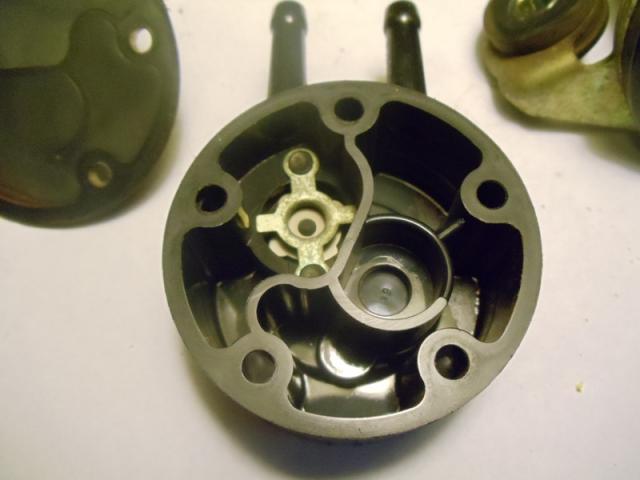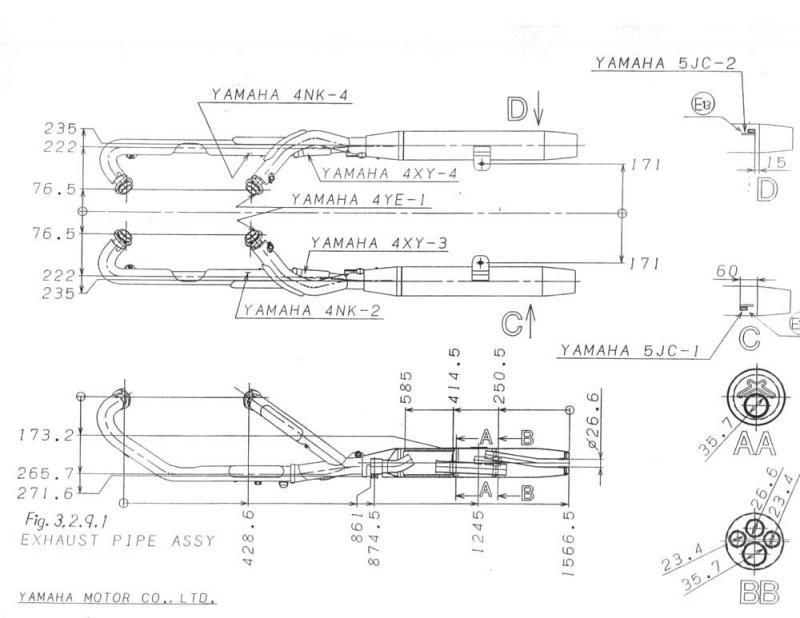-
Posts
3,621 -
Joined
-
Last visited
Content Type
Profiles
Forums
Gallery
Events
Store
Everything posted by Prairiehammer
-
Don, put a donation can outside the Porta Pottie AND inside the Porta Pottie. "Please deposit $1 to get in." "Please deposit $1 to get out." And don't forget the cost of restocking the pond. All those yahoos who refuse to pay a buck for the Porta Potty are gonna kill your fish and maybe even the Pond Monster (although, THAT might not be a bad thing).
-
" [h=2]Mystery bike identity reviled ???"[/h] Was that a Freudian slip? The "Reviled" part. Was it supposed to be "Revealed"? Because "Reviled" is more apropos.
-
Dick, The CV carbs are intrinsically self adjusting for altitude. Something to do with vacuum, negative and positive pressure and interaction with atmospheric pressure and altitude. It means for us flatlanders who might occasionally head for the hills, that our bikes don't suffer as much as non-CV carbed bikes with "altitude sickness". Having said that, if you (and you are) were spending all your time in the mountains, then jet modifications will be a good, albeit finicky, endeavor. Here is a copy and paste of one guy's take on jetting the Vmax/Venture carbs for high altitude. Keep in mind, that the actual size of the jets he talks about are for a Vmax. "Hope you don't mind me jumping in here, but we recently redid the carbs on my V-max (I assume the Venture is very similar) and got some clarification from one of my friends that is a technical expert on the Max...keep in mind this is for an adjustment to Colorado altitude: What we're going to do is replace the main jets in your float bowls with a 145 Mikuni jet. The stock jetting is a 152.5 which is a bit rich at sea level for a stock bike and WAY rich for a bike at 5000+ feet altitude. This will make the bike run more crisp along with giving it a better top end and better fuel mileage. Shane, you know what I mean by top end after seeing how easily I take my bike to 140+. It never pulled like that when I had the stock jetting in it. There is actually a calculation for determining jetting at altitude. Anyway, that's the story behind the main jet selection. The mains always have to be selected first. Without a good main jet selected, all the other 'circuits' of the carb will never be right. Now the 'pilot fuel jet' is the one that is size 42.5 Stock on a 49 state bike is 37.5 I don't know what a California bike has but I'll bet it's leaner if anything. With the 42.5 you won't have to have the idle mixture screws out so far and you'll also have a better crossover from idle to midrange. All in all, this means no more popping out the carb throats when you gas it from idle. The 'pilot air jet' is part of the same circuit that the we use the 'pilot fuel jet' in. Fuel jets let fuel in and air jets let air in to make a mixture that is fed down the carb throat at idle and slightly above. The 'pilot air jet' and the 'pilot fuel jet' both work together to give a proper mixture at idle and also up through midrange when using small throttle openings. In other words when you are cruising with the throttle held open just a bit. Like when you're going 30, 40, 50, or 60 MPH. It's this jetting arrangement that is too lean from the factory. This helps the factory get past missions testing. It's also the reason that the main is too big. They try and use a larger, too large in fact for best power, main jet to help compensate for a very lean idle mixture. As you can see from the popping that every stock jetted Vmax is plagued with, it's not a very good compromise. This is what we're attempting to fix. Now, this air jet I just mentioned is the same size (not the hole, but the physical size and the threads) as the main jet. That's why I told you guys to get 95 main jets. But Yamaha probably doesn't have a listing for a main of that size. Soooo, what you do is just order a 95 'pilot air jet,' because that is what it really is. You'll see when you get it that it's the EXACT same as your new main jets, just a number 95 and not a 145. The other 'pilot air jet' is called PAJ2,,, meaning 'pilot air jet number 2. It has an effect through the midrange before the jet needle takes over. This also is the same size as a main jet and that's also why I told you to get a 160 main jet. We just won't be using it in the main jet location. In this case, the stock jet (PAJ2) is a 170 and we are going to a 160. When fuel jets get larger, it means you're going richer. When air jets get larger, it means you're going leaner. Because fuel jets let in raw gas and air jets let in air. Basically, more fuel= richer,,, more air= leaner. What we really are dealing with is: 4 main jets in the size of '145' (3G2-14231-29-00) 4 pilot fuel jets in the size of '42.5' (4G0-14142-42-A0) 4 pilot air jets number 1 (PAJ1) in the size of '95' (3G2-14231-19-00) 4 pilot air jets number 2 (PAJ2) in the size of '160'" (3G2-14231-32- 00) In addition you may also need the jet block gaskets (3JB-14199-00-00) depending on the age of your bike and the condition of your current gaskets. Nimalex "
-
You mean one of those little vibrating point engravers? That you hold like a pencil and the hardened tip vibrates and scratches the thing you are trying to etch? If so, I have one and I will bring it. Or do you mean one that spins a burr on the tip? Hope I have enough room. The "library" I am bringing for Dingy is taking up a lot of room.
-

Front brake frustration
Prairiehammer replied to Mad Dog's topic in Royal Star Venture Tech Talk ('99 - '13)
Here is the proper orientation of the master cylinder piston and seals. The pic shows the orientation for the rear brake on a First Gen, but the same basic orientation is the same on all master cylinders. -
Gary, Gary, Gary...what are we gonna do wit'chu? So, Lisa didn't get the second one in the crate behind you. Dastardly, I say, dastardly. Bastard!
-
That stuff must have been what they used at the dealership where I bought my '91. Little white dots everywhere the 'kid' didn't wipe it down.
-
Note to self...pack the ear plugs.
-

Replace Fuel Pump?
Prairiehammer replied to Donvito's topic in Venture and Venture Royale Tech Talk ('83 - '93)
There has been one instance of one of the poppet valves in the First Gen fuel pump becoming misplaced or cocked, thus preventing it's proper operation. There are two of these valves. One is opened on the intake stroke of the pump armature while the other is closed. When the discharge stroke happens that first valve closes and the other opens. If one or the other fails to open or close properly, the pump does not 'pump'. As in the Second Gen fuel pump, the points may be sticking and/or burnt, causing intermittent operation. The 'roll-over valve' (check valve in the tank vent) may be malfunctioning (stuck closed) or the tank vent line may be otherwise obstructed, preventing proper venting of the fuel tank. As fuel is drawn out of the tank and air is prevented from entering the tank, a vacuum is formed, impeding the pump from getting fuel to pump to the carbs. -
Five year warranty?
-

First Gen Carb Diaphragms
Prairiehammer replied to stickhandle2's topic in Venture and Venture Royale Tech Talk ('83 - '93)
Dibs! How much? -
-
You have a white seat? Your tires aren't black?
-

pictures of my g breaks
Prairiehammer replied to cruiserlover's topic in Royal Star Venture Tech Talk ('99 - '13)
I wiped down the tar speckled lowest cowling on my 1990 with MEK in an attempt to quickly remove tar. It dulled the paint a good deal and the paint was tacky until the MEK evaporated. You could see the streaks left by the rag; like brush marks. On the 1991, I applied a drop of MEK to a crack in the trunk lid. I applied the MEK from the interior of the lid. As expected, the MEK wicked the length of the crack and solvent welded the fissure. But it also bubbled the paint on the exterior of the crack. The welded crack was now quite visible, whereas it was almost invisible before. The bubbled paint made the crack obvious. So, I am going to stand by my assertion that MEK will harm the paint on the Venture. -

pictures of my g breaks
Prairiehammer replied to cruiserlover's topic in Royal Star Venture Tech Talk ('99 - '13)
If you let a puddle of the MEK sit on the ABS it will melt it. But just wiping the MEK will clean and prime the ABS. It will soften the surface of the ABS but the MEK will evaporate before hurting the ABS. Just use a little at time on a corner of a rag. I used a syringe once to apply MEK to a crack in my trunk. Worked ok, but the MEK melted the syringe and the plunger. A drop of MEK from a teeny, tiny natural hair artists brush will allow you to apply just what you need where you need it. The MEK will wick all the way to the end of a TIGHT crack just by capillary action. Hold the crack together for a minute and the crack will be welded closed. On large cracks and edges where the ABS is missing, use the MEK to prep the crack and edges for the ABS cement. -

pictures of my g breaks
Prairiehammer replied to cruiserlover's topic in Royal Star Venture Tech Talk ('99 - '13)
It might be in the plumbing section with the ABS cement, but I found a quart can of MEK (Methyl ethyl ketone) in the paint section of the local Menards. BTW, make sure the ABS cement is for ABS only and not for ABS/PVC. And no, PVC cement doesn't work well on ABS. MEK is a powerful solvent. Be careful using it around any plastic and painted surfaces. It will melt ABS and strip paint. -

pictures of my g breaks
Prairiehammer replied to cruiserlover's topic in Royal Star Venture Tech Talk ('99 - '13)
While some will maintain the fiberglass resin (polyester resin) can be used to repair ABS, many others have shown that fiberglass resin is not a long term fix to cracked ABS components. It just doesn't stay stuck. Use the ABS cement, the self adhesive metal mesh patches and the fiberglass mesh, but forego the fiberglass resin. Embed the various reinforcements in ABS cement, not resin. And use MEK solvent as a primer for the ABS cement. Straight MEK solvent will wick into tight cracks and actually solvent weld the ABS cracks without the use of ABS cement. -

quieting mufflers back down
Prairiehammer replied to cruiserlover's topic in Royal Star Venture Tech Talk ('99 - '13)
Here is a diagram of how the stock RSV mufflers are constructed internally. Perhaps a clue to how to restore the mufflers? -
Do you Second Gen guys feel left out? Do you wish that there was a drawing of your Venture to color? Well, chin up Bunkie, here ya go. I even left off the eyebrows and the tank badge for you folks who have removed yours.
-

spark issue help! PLEASE
Prairiehammer replied to jdog910's topic in Venture and Venture Royale Tech Talk ('83 - '93)
-

High idle with an overheat
Prairiehammer replied to Hard Likr's topic in Venture and Venture Royale Tech Talk ('83 - '93)
Firstly, the slightly over half way up is not overheating. With a marginal cooling system that is normal. A good condition cooling system will run only slightly cooler. Secondly, the fact that the revs increase as it gets a tad too warm, indicates a lean condition. Two likely culprits: a vacuum or air leak in the induction system; and or a partially plugged pilot circuit in one or more carbs. Lean condition will cause the slightly higher than normal temperature and then the overly high revs will tend to raise the temp. Vicious circle. Begin by searching for a vacuum or air leak by spraying carb cleaner around the carb boots, the "Boost Sensor" and it's hose, the synch port caps, etc. Any sudden increase in idle speed indicates a leak. Lower the idle speed to under 900 rpms. Check the pilot screws (idle mixture screws) for their current settings. Do this by screwing a pilot screw in until it GENTLY bottoms, counting the number of turns to seat the pilot screw. On a normal engine, it is typical about 2½ turns in to seat. Note also, when you GENTLY seat each pilot screw, whether the engine idle speed changes; the idle should drop. If it does not, then you have found a dirty pilot circuit. The idle picks up when that faulty cylinder starts to fire consistently because it is starting to transition to the mid range fuel delivery. A poor carb synch will also contribute to your over revving. Probably number two carb is open more than the rest at idle. Number two cylinder is also where the vacuum advance (Boost Sensor) receives its signal. If you pull the vacuum hose from the number 2 synch port (removing the vacuum signal to the Boost Sensor) and PLUG THE PORT, when it is over revving, does the idle speed drop? Finally, is it a California intended Venture? What is the full VIN? -
The "Royale" emblems are just stick on with double faced foam tape (in fact, ALL the various emblems, badges, name plates on the plastic are applied using 'trim' tape). Perhaps the PO decided to put all the Royale features on the Standard, including the Royale emblems. So you have Yamaha factory audio system complete with CB? Do you have CLASS air suspension controller and compressor?



.jpg.61a1dd1a1b6081ca19b83f55625984d9.jpg)





.jpg.fe66329f18671a8927c03bc470279461.jpg)


.thumb.jpg.d2d40e31f539ae9e6840fe9aced357e8.jpg)